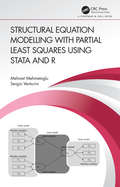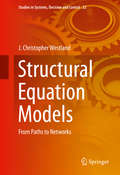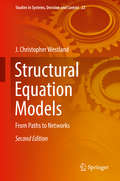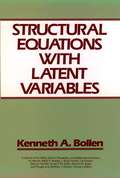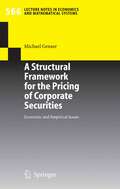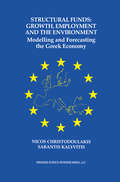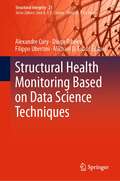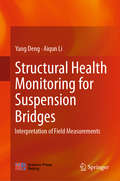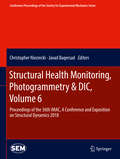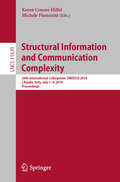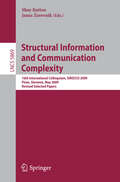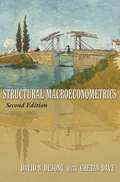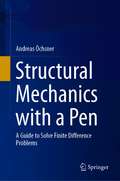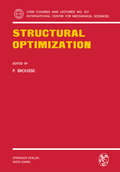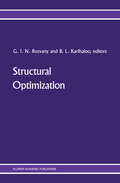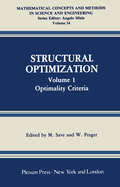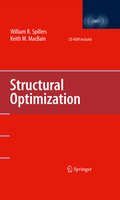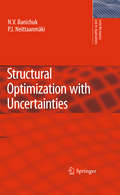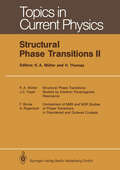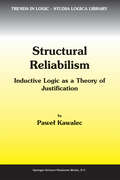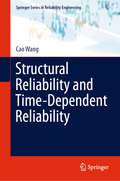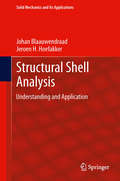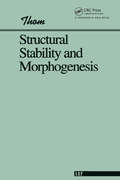- Table View
- List View
Structural Equation Modelling with Partial Least Squares Using Stata and R
by Mehmet Mehmetoglu Sergio VenturiniPartial least squares structural equation modelling (PLS-SEM) is becoming a popular statistical framework in many fields and disciplines of the social sciences. The main reason for this popularity is that PLS-SEM can be used to estimate models including latent variables, observed variables, or a combination of these. The popularity of PLS-SEM is predicted to increase even more as a result of the development of new and more robust estimation approaches, such as consistent PLS-SEM. The traditional and modern estimation methods for PLS-SEM are now readily facilitated by both open-source and commercial software packages. This book presents PLS-SEM as a useful practical statistical toolbox that can be used for estimating many different types of research models. In so doing, the authors provide the necessary technical prerequisites and theoretical treatment of various aspects of PLS-SEM prior to practical applications. What makes the book unique is the fact that it thoroughly explains and extensively uses comprehensive Stata (plssem) and R (cSEM and plspm) packages for carrying out PLS-SEM analysis. The book aims to help the reader understand the mechanics behind PLS-SEM as well as performing it for publication purposes. Features: Intuitive and technical explanations of PLS-SEM methods Complete explanations of Stata and R packages Lots of example applications of the methodology Detailed interpretation of software output Reporting of a PLS-SEM study Github repository for supplementary book material The book is primarily aimed at researchers and graduate students from statistics, social science, psychology, and other disciplines. Technical details have been moved from the main body of the text into appendices, but it would be useful if the reader has a solid background in linear regression analysis.
Structural Equation Models: From Paths to Networks (Studies in Systems, Decision and Control #22)
by J. Christopher WestlandThis compact reference surveys the full range of available structural equation modeling (SEM) methodologies. It reviews applications in a broad range of disciplines, particularly in the social sciences where many key concepts are not directly observable. This is the first book to present SEM’s development in its proper historical context–essential to understanding the application, strengths and weaknesses of each particular method. This book also surveys the emerging path and network approaches that complement and enhance SEM, and that will grow importance in the near future. SEM’s ability to accommodate unobservable theory constructs through latent variables is of significant importance to social scientists. Latent variable theory and application are comprehensively explained and methods are presented for extending their power, including guidelines for data preparation, sample size calculation and the special treatment of Likert scale data. Tables of software, methodologies and fit statistics provide a concise reference for any research program, helping assure that its conclusions are defensible and publishable.
Structural Equation Models: From Paths to Networks (Studies in Systems, Decision and Control #22)
by J. Christopher WestlandThis new edition surveys the full range of available structural equation modeling (SEM) methodologies. The book has been updated throughout to reflect the arrival of new software packages, which have made analysis much easier than in the past. Applications in a broad range of disciplines are discussed, particularly in the social sciences where many key concepts are not directly observable. This book presents SEM’s development in its proper historical context–essential to understanding the application, strengths and weaknesses of each particular method. This book also surveys the emerging path and network approaches that complement and enhance SEM, and that are growing in importance. SEM’s ability to accommodate unobservable theory constructs through latent variables is of significant importance to social scientists. Latent variable theory and application are comprehensively explained and methods are presented for extending their power, including guidelines for data preparation, sample size calculation and the special treatment of Likert scale data. Tables of software, methodologies and fit statistics provide a concise reference for any research program, helping assure that its conclusions are defensible and publishable.
Structural Equations with Latent Variables (Wiley Series in Probability and Statistics #210)
by Kenneth A. BollenAnalysis of Ordinal Categorical Data Alan Agresti Statistical Science Now has its first coordinated manual of methods for analyzing ordered categorical data. This book discusses specialized models that, unlike standard methods underlying nominal categorical data, efficiently use the information on ordering. It begins with an introduction to basic descriptive and inferential methods for categorical data, and then gives thorough coverage of the most current developments, such as loglinear and logit models for ordinal data. Special emphasis is placed on interpretation and application of methods and contains an integrated comparison of the available strategies for analyzing ordinal data. This is a case study work with illuminating examples taken from across the wide spectrum of ordinal categorical applications. 1984 (0 471-89055-3) 287 pp. Regression Diagnostics Identifying Influential Data and Sources of Collinearity David A. Belsley, Edwin Kuh and Roy E. Welsch This book provides the practicing statistician and econometrician with new tools for assessing the quality and reliability of regression estimates. Diagnostic techniques are developed that aid in the systematic location of data points that are either unusual or inordinately influential; measure the presence and intensity of collinear relations among the regression data and help to identify the variables involved in each; and pinpoint the estimated coefficients that are potentially most adversely affected. The primary emphasis of these contributions is on diagnostics, but suggestions for remedial action are given and illustrated. 1980 (0 471-05856-4) 292 pp. Applied Regression Analysis Second Edition Norman Draper and Harry Smith Featuring a significant expansion of material reflecting recent advances, here is a complete and up-to-date introduction to the fundamentals of regression analysis, focusing on understanding the latest concepts and applications of these methods. The authors thoroughly explore the fitting and checking of both linear and nonlinear regression models, using small or large data sets and pocket or high-speed computing equipment. Features added to this Second Edition include the practical implications of linear regression; the Durbin-Watson test for serial correlation; families of transformations; inverse, ridge, latent root and robust regression; and nonlinear growth models. Includes many new exercises and worked examples. 1981 (0 471-02995-5) 709 pp.
Structural Equations with Latent Variables (Wiley Series in Probability and Statistics #210)
by Kenneth A. BollenAnalysis of Ordinal Categorical Data Alan Agresti Statistical Science Now has its first coordinated manual of methods for analyzing ordered categorical data. This book discusses specialized models that, unlike standard methods underlying nominal categorical data, efficiently use the information on ordering. It begins with an introduction to basic descriptive and inferential methods for categorical data, and then gives thorough coverage of the most current developments, such as loglinear and logit models for ordinal data. Special emphasis is placed on interpretation and application of methods and contains an integrated comparison of the available strategies for analyzing ordinal data. This is a case study work with illuminating examples taken from across the wide spectrum of ordinal categorical applications. 1984 (0 471-89055-3) 287 pp. Regression Diagnostics Identifying Influential Data and Sources of Collinearity David A. Belsley, Edwin Kuh and Roy E. Welsch This book provides the practicing statistician and econometrician with new tools for assessing the quality and reliability of regression estimates. Diagnostic techniques are developed that aid in the systematic location of data points that are either unusual or inordinately influential; measure the presence and intensity of collinear relations among the regression data and help to identify the variables involved in each; and pinpoint the estimated coefficients that are potentially most adversely affected. The primary emphasis of these contributions is on diagnostics, but suggestions for remedial action are given and illustrated. 1980 (0 471-05856-4) 292 pp. Applied Regression Analysis Second Edition Norman Draper and Harry Smith Featuring a significant expansion of material reflecting recent advances, here is a complete and up-to-date introduction to the fundamentals of regression analysis, focusing on understanding the latest concepts and applications of these methods. The authors thoroughly explore the fitting and checking of both linear and nonlinear regression models, using small or large data sets and pocket or high-speed computing equipment. Features added to this Second Edition include the practical implications of linear regression; the Durbin-Watson test for serial correlation; families of transformations; inverse, ridge, latent root and robust regression; and nonlinear growth models. Includes many new exercises and worked examples. 1981 (0 471-02995-5) 709 pp.
A Structural Framework for the Pricing of Corporate Securities: Economic and Empirical Issues (Lecture Notes in Economics and Mathematical Systems #566)
by Michael GenserStructural Funds: Modelling and Forecasting the Greek Economy
by Nicos Christodoulakis Sarantis KalyvitisStructural Funds: Growth, Employment and the Environment is a book on the role of transfers designed for assisting sustainable development of less developed regions within the European Union. The book places special emphasis on the future path of the Greek economy and discusses likely outcomes -related directly to the impact of these transfers- in: Growth and macroeconomic convergence Employment in key sectors of the economy Energy demand and its environmental aspect The book uses macroeconomic modelling and modern applied econometric techniques to analyze these issues, thus offering a coherent methodological framework for their presentation. To this extent, Structural Funds: Growth, Employment and the Environment can serve to: Academic researchers and economists in recipient countries who can gain a better understanding of how national authorities can best design and implement the strategic allocation and utilization of these funds to maximize the benefits for the domestic economy Policymakers in the European Union by offering a sound and rigorously elaborated treatment which can be applied as an estimation and comparison tool for the effects of Structural Funds both at the national and the international level Economists in Eastern European countries which are at the pre-accession stage and will be eligible for this type of transfers in the near future.
Structural Health Monitoring Based on Data Science Techniques (Structural Integrity #21)
by Alexandre Cury Diogo Ribeiro Filippo Ubertini Michael D. ToddThe modern structural health monitoring (SHM) paradigm of transforming in situ, real-time data acquisition into actionable decisions regarding structural performance, health state, maintenance, or life cycle assessment has been accelerated by the rapid growth of “big data” availability and advanced data science. Such data availability coupled with a wide variety of machine learning and data analytics techniques have led to rapid advancement of how SHM is executed, enabling increased transformation from research to practice. This book intends to present a representative collection of such data science advancements used for SHM applications, providing an important contribution for civil engineers, researchers, and practitioners around the world.
Structural Health Monitoring for Suspension Bridges: Interpretation of Field Measurements
by Yang Deng Aiqun LiThis book presents extensive information on structural health monitoring for suspension bridges. During the past two decades, there have been significant advances in the sensing technologies employed in long-span bridge health monitoring. However, interpretation of the massive monitoring data is still lagging behind. This book establishes a series of measurement interpretation frameworks that focus on bridge site environmental conditions, and global and local responses of suspension bridges. Using the proposed frameworks, it subsequently offers new insights into the structural behaviors of long-span suspension bridges. As a valuable resource for researchers, scientists and engineers in the field of bridge structural health monitoring, it provides essential information, methods, and practical algorithms that can facilitate in-service bridge performance assessments.
Structural Health Monitoring, Photogrammetry & DIC, Volume 6: Proceedings of the 36th IMAC, A Conference and Exposition on Structural Dynamics 2018 (Conference Proceedings of the Society for Experimental Mechanics Series)
by Christopher Niezrecki Javad BaqersadStructural Health Monitoring Photogrammetry & DIC, Volume 6: Proceedings of the 36th IMAC, A Conference and Exposition on Structural Dynamics, 2018, the sixth volume of nine from the Conference brings together contributions to this important area of research and engineering. The collection presents early findings and case studies on fundamental and applied aspects of Structural Health Monitoring & Damage Detection, including papers on:Structural Health MonitoringDamage DetectionSystem IdentificationActive Controls
Structural Information and Communication Complexity: 26th International Colloquium, SIROCCO 2019, L'Aquila, Italy, July 1–4, 2019, Proceedings (Lecture Notes in Computer Science #11639)
by Keren Censor-Hillel Michele FlamminiThis book constitutes the refereed conference proceedings of the 26th International Colloquium on Structural Information and Communication Complexity, SIROCCO 2019, held in L’Aquila, Italy, in July 2019.The 19 full papers and 9 short papers presented in this book were carefully reviewed and selected from 39 submissions. They are devoted to the study of the interplay between structural knowledge, communication, and computing in decentralized systems of multiple communicating entities.
Structural Information and Communication Complexity: 16th International Colloquium, SIROCCO 2009, Piran, Slovenia, May 25-27, 2009, Revised Selected Papers (Lecture Notes in Computer Science #5869)
by Shay Kutten Janez 381 ErovnikStructural Macroeconometrics: Second Edition
by David N. Dejong Chetan DaveStructural Macroeconometrics provides a thorough overview and in-depth exploration of methodologies, models, and techniques used to analyze forces shaping national economies. In this thoroughly revised second edition, David DeJong and Chetan Dave emphasize time series econometrics and unite theoretical and empirical research, while taking into account important new advances in the field. The authors detail strategies for solving dynamic structural models and present the full range of methods for characterizing and evaluating empirical implications, including calibration exercises, method-of-moment procedures, and likelihood-based procedures, both classical and Bayesian. The authors look at recent strides that have been made to enhance numerical efficiency, consider the expanded applicability of dynamic factor models, and examine the use of alternative assumptions involving learning and rational inattention on the part of decision makers. The treatment of methodologies for obtaining nonlinear model representations has been expanded, and linear and nonlinear model representations are integrated throughout the text. The book offers a rich array of implementation algorithms, sample empirical applications, and supporting computer code. Structural Macroeconometrics is the ideal textbook for graduate students seeking an introduction to macroeconomics and econometrics, and for advanced students pursuing applied research in macroeconomics. The book's historical perspective, along with its broad presentation of alternative methodologies, makes it an indispensable resource for academics and professionals.
Structural Macroeconometrics: Second Edition
by David N. Dejong Chetan DaveStructural Macroeconometrics provides a thorough overview and in-depth exploration of methodologies, models, and techniques used to analyze forces shaping national economies. In this thoroughly revised second edition, David DeJong and Chetan Dave emphasize time series econometrics and unite theoretical and empirical research, while taking into account important new advances in the field. The authors detail strategies for solving dynamic structural models and present the full range of methods for characterizing and evaluating empirical implications, including calibration exercises, method-of-moment procedures, and likelihood-based procedures, both classical and Bayesian. The authors look at recent strides that have been made to enhance numerical efficiency, consider the expanded applicability of dynamic factor models, and examine the use of alternative assumptions involving learning and rational inattention on the part of decision makers. The treatment of methodologies for obtaining nonlinear model representations has been expanded, and linear and nonlinear model representations are integrated throughout the text. The book offers a rich array of implementation algorithms, sample empirical applications, and supporting computer code. Structural Macroeconometrics is the ideal textbook for graduate students seeking an introduction to macroeconomics and econometrics, and for advanced students pursuing applied research in macroeconomics. The book's historical perspective, along with its broad presentation of alternative methodologies, makes it an indispensable resource for academics and professionals.
Structural Mechanics with a Pen: A Guide to Solve Finite Difference Problems
by Andreas ÖchsnerThis book is focused on the introduction of the finite difference method based on the classical one-dimensional structural members, i.e., rods/bars and beams. It is the goal to provide a first introduction to the manifold aspects of the finite difference method and to enable the reader to get a methodical understanding of important subject areas in structural mechanics. The reader learns to understand the assumptions and derivations of different structural members. Furthermore, she/he learns to critically evaluate possibilities and limitations of the finite difference method. Additional comprehensive mathematical descriptions, which solely result from advanced illustrations for two- or three-dimensional problems, are omitted. Hence, the mathematical description largely remains simple and clear.
Structural Optimization: Proceedings of the IUTAM Symposium on Structural Optimization, Melbourne, Australia, 9–13 February 1988
by George I. N. Rozvany B. L. KarihalooProceedings of the IUTAM Symposium on Structural Optimization, Melbourne, Australia, February 9-13, 1988
Structural Optimization: Volume 1: Optimality Criteria (Mathematical Concepts and Methods in Science and Engineering #34)
by M. Save W. PragerAfter the IUTAM Symposium on Optimization in Structural Design held in Warsaw in 1973, it was clear to me that the time had come for organizing into a consistent body of thought the enormous quantity of results obtained in this domain, studied from so many different points of view, with so many different methods, and at so many levels of practical applicability. My colleague and friend Gianantonnio Sacchi from Milan and I met with Professor Prager in Savognin in July 1974, where I submitted to them my first ideas for a treatise on structural optimization: It should cover the whole domain from basic theory to practical applications, and deal with various materials, various types of structures, various functions required of the structures, and various types of cost . . Obviously, this was to be a team effort, to total three or four volumes, to be written in a balanced manner as textbooks and handbooks. Nothing similar existed at that time, and, indeed, nothing has been published to date. Professor Prager was immedi ately in favor of such a project. He agreed to write a first part on optimality criteria with me and to help me in the general organization of the series. Since Professor Sacchi was willing to write the text on variational methods, it remained to find authors for parts on the mathematical programming approach to structural optimization (and, more generally, on numerical methods) and on practical optimal design procedures in metal and concrete.
Structural Optimization
by William R. Spillers Keith M. MacBainStructural Optimization is intended to supplement the engineer’s box of analysis and design tools making optimization as commonplace as the finite element method in the engineering workplace. It begins with an introduction to structural optimization and the methods of nonlinear programming such as Lagrange multipliers, Kuhn-Tucker conditions, and calculus of variations. It then discusses solution methods for optimization problems such as the classic method of linear programming which leads to the method of sequential linear programming. It then proposes using sequential linear programming together with the incremental equations of structures as a general method for structural optimization. It is furthermore intended to give the engineer an overview of the field of structural optimization.
Structural Optimization with Uncertainties (Solid Mechanics and Its Applications #162)
by N.V. Banichuk Pekka NeittaanmäkiStructural optimization is currently attracting considerable attention. Interest in - search in optimal design has grown in connection with the rapid development of aeronautical and space technologies, shipbuilding, and design of precision mach- ery. A special ?eld in these investigations is devoted to structural optimization with incomplete information (incomplete data). The importance of these investigations is explained as follows. The conventional theory of optimal structural design - sumes precise knowledge of material parameters, including damage characteristics and loadings applied to the structure. In practice such precise knowledge is seldom available. Thus, it is important to be able to predict the sensitivity of a designed structure to random ?uctuations in the environment and to variations in the material properties. To design reliable structures it is necessary to apply the so-called gu- anteed approach, based on a “worst case scenario” or a more optimistic probabilistic approach, if we have additional statistical data. Problems of optimal design with incomplete information also have consid- able theoretical importance. The introduction and investigations into new types of mathematical problems are interesting in themselves. Note that some ga- theoretical optimization problems arise for which there are no systematic techniques of investigation. This monograph is devoted to the exposition of new ways of formulating and solving problems of structural optimization with incomplete information. We recall some research results concerning the optimum shape and structural properties of bodies subjected to external loadings.
Structural Phase Transitions II (Topics in Current Physics #45)
by K. A. Müller J. C. Fayet F. Borsa A. RigamontiStructural Phase Transitions II, like its predecessor (Topics in Current Physics, Vol. 23), presents selected methods and recent advances in the experimental investigation of phase transitions in solids. The two chapters in this volume deal with electron paramagnetic resonance (EPR), and with nuclear magnetic and nuclear quadrupole resonance (NMR-NQR). Both techniques are particularly sensitive to local properties. The chapter on EPR concentrates largely on the investigation of static properties, including mean-field behaviour, critical and multicritical phenomena, whilst NMR is shown to be a powerful tool for studying nonlinear dynamics, incommensurate transitions, and disordered systems. This book will serve as an excellent introduction to the methodology and applications of EPR and NMR-NQR for all those wishing to become acquainted with these important tools for studying structural phase transitions.
Structural Reliabilism: Inductive Logic as a Theory of Justification (Trends in Logic #16)
by P. KawalecKawalec's monograph is a novel defence of the programme of inductive logic, developed initially by Rudolf Carnap in the 1950s and Jaakko Hintikka in the 1960s. It revives inductive logic by bringing out the underlying epistemology. The main strength of the work is its link between inductive logic and contemporary discussions of epistemology. Through this perspective the author succeeds to shed new light on the significance of inductive logic. The resulting structural reliabilist theory propounds the view that justification supervenes on syntactic and semantic properties of sentences as justification-bearers. The claim is made that this sets up a genuine alternative to the prevailing theories of justification. Kawalec substantiates this claim by confronting structural reliabilism with a number of epistemological problems. Kawalec writes in a clear manner, makes his theses and arguments explicit, and gives ample bibliographical references.
Structural Reliability and Time-Dependent Reliability (Springer Series in Reliability Engineering)
by Cao WangThis book provides structural reliability and design students with fundamental knowledge in structural reliability, as well as an overview of the latest developments in the field of reliability engineering. It addresses the mathematical formulation of analytical tools for structural reliability assessment. This book offers an accessible introduction to structural reliability assessment and a solid foundation for problem-solving. It introduces the topic and background, before dealing with probability models for random variables. It then explores simulation techniques for single random variables, random vectors consisting of different variables, and stochastic processes. The book addresses analytical approaches for structural reliability assessment, including the reliability models for a single structure and those for multiple structures, as well as discussing the approaches for structural time-dependent reliability assessment in the presence of discrete and continuous load processes. This book delivers a timely and pedagogical textbook, including over 170 worked-through examples, detailed solutions, and analytical tools, making it of interest to a wide range of graduate students, researchers, and practitioners in the field of reliability engineering.
Structural Shell Analysis: Understanding and Application (Solid Mechanics and Its Applications #200)
by Johan Blaauwendraad Jeroen H. HoefakkerThe mathematical description of the properties of a shell is much more elaborate than those of beam and plate structures. Therefore many engineers and architects are unacquainted with aspects of shell behaviour and design, and are not familiar with sufficiently reliable shell theories for the different shell types as derived in the middle of the 20th century. Rather than contributing to theory development, this university textbook focuses on architectural and civil engineering schools. Of course, practising professionals will profit from it as well. The book deals with thin elastic shells, in particular with cylindrical, conical and spherical types, and with elliptic and hyperbolic paraboloids. The focus is on roofs, chimneys, pressure vessels and storage tanks. Special attention is paid to edge bending disturbance zones, which is indispensable knowledge in FE meshing. A substantial part of the book results from research efforts in the mid 20th century at Delft University of Technology. As such, it is a valuable addition to the body of shell research literature of continuing importance. This work can be used for university courses. It also shows professionals how to perform manual calculations of the main force flow in shell structures, and provides guidance for structural engineers estimating stresses and deformations.
Structural Stability And Morphogenesis
by Rene ThomFirst Published in 2018. Routledge is an imprint of Taylor & Francis, an Informa company.
